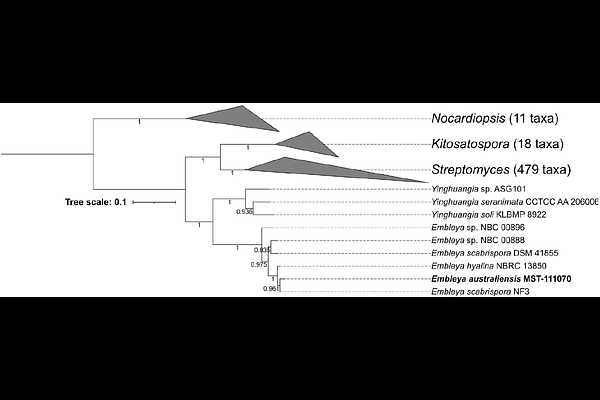Evidence supporting the first secondary chromosome in actinobacteria as a hallmark of the Embleya genus

Evidence supporting the first secondary chromosome in actinobacteria as a hallmark of the Embleya genus
Gomez-Escribano, J. P.; Dorai-Raj, S.; Baker, D.; Lacey, E.; Wilkinson, B.; Booth, T. J.
AbstractEmbleya is a genus within the family Streptomycetaceae, a group of actinobacteria with outstanding capacity for production of specialised metabolites and a strikingly complex life cycle. In this work, we sequenced the complete genome of the new species Embleya australiensis MST-11070 and validated the assembly using optical mapping. The genome of E. australiensis MST-11070 consists of a 7.1 Mb linear chromosome and three additional replicons, including a 4.2 Mb linear replicon, EEC1, significantly larger than all previously described secondary replicons from bacteria. EEC1 is typified by its similar composition to the chromosome in terms of GC-content, codon usage and gene functions. It also carries terminal inverted repeats identical to the chromosome. EEC1 is enriched in biosynthetic gene clusters (BGCs), including the only copy of the BGCs for the spore pigment and the surfactant peptide SapB, metabolites essential for the organism\'s lifecycle. EEC1 contains an origin of replication with at least some chromosomal properties, and its replication is likely to depend on functions provided by chromosomally located genes. Further comparison of Embleya spp. genomes suggests that EEC1-like replicons are conserved across the genus, in contrast to other known large linear extrachromosomal replicons (megaplasmids) in the order. EEC1 is thus a hallmark of the Embleya genus and is central to its evolution within the Streptomycetaceae family. We propose EEC1 as a secondary chromosome, distinct from previously described secondary chromosomes that utilise plasmid-like replication mechanisms (chromids) and the largest secondary replicon reported in bacteria, to date.